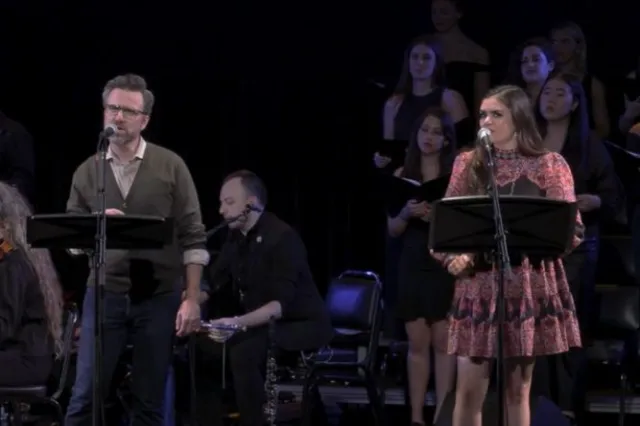Review: Radical Access Takes Center Stage in Ryan J. Haddad’s Dark Disabled Stories
The Public Theater and Bushwick Starr present this new work from the writer of Hi, Are You Single?
When you hear the phrase “accessible performance,” you likely imagine a theater having a single autism-friendly or ASL-interpreted show, or maybe wheelchair-user-accessible seating, or perhaps even an autism-friendly elements. Ryan J. Haddad’s Dark Disabled Stories at the Public Theater (co-presented by the Bushwick Starr and directed by Jordan Fein) takes access to much deeper levels. This becomes abundantly clear even before the play begins: the program contains a note by the “access dramaturg” Alison Kopit, something quite singular in and of itself. In the note, Kopit writes, “Access is not an add-on to the show–it is the show.”
This powerful sentence acts as both preamble and thesis statement for the play to come, which foregrounds access in ways that are nothing short of radical. The play includes audio description (by Alejandra Ospina) of the action, projected captions, and a Deaf actor (Dickie Hearts) giving an artistic sign language performance of all Haddad’s spoken text. Hearts, as he tells us, is not an interpreter; he is an actor performing, an integrated part of the piece. Likewise, Ospina, who uses a powerchair, joins the action as well, and is in every sense a part of the work.
Our main performer, though, is playwright Haddad. Haddad, a disabled artist with cerebral palsy, has had several one-man autobiographical shows (Hi, Are You Single?; Falling for Make Believe), but here he expands his world to include Ospina and Hearts, as well as their stories and perspectives, which opens up not only the content of this play, but also the focus on accessibility more broadly. As Haddad explains toward the top of the show, while he often works to make disability more accessible to non-disabled audiences, in this play he is not doing that. Not everything is accessible to disabled people, so why should they work to make their experience accessible to an outsider audience?
Like Haddad’s other pieces, this play is a string of related autobiographical vignettes about disability, though his themes here are both expanded and cohesive. The scenes all revolve around issues of access and (in)accessibility around infrastructure, tribulations of dating while disabled and queer, struggles in accepting assistance, and everyday encounters with ableism. We hear about various problematic encounters on the bus, broken subway elevators, exploitative hookups, seemingly benevolent strangers who hope Ryan finds a cure someday, and moments where Ryan urgently needs a bathroom or falls but does not want to ask for help for fear of seeming dependent, helpless, or too disabled. (A final vignette attempts to also tackle police brutality and racism, which feels both ambitious and like a different show, especially with a much more logical conclusion coming right before it).
While many of the stories can be heavy, the play is undeniably funny. Haddad is a comedic genius; with his sly grin, playful inflections, and flirtatious gestures, he always manages to secure a laugh from the audience. Likewise, Hearts highlights the poetry of ASL performance, and how it can often aid to the humor of a piece. This play proves that disability need not be seen as something sad, tragic, or “dark.” It can be funny, messy, sexy, and complicated.
Dark Disabled Stories not only prioritizes radical forms of access, but also works to legitimately center disabled people (and de-center non-disabled people). What’s more, this isn’t just lip service, they practice what they preach. The audience was one of the most diverse I’ve ever been part of, and included more visibly disabled people than I had ever witnessed in an audience before–due not only to the subject material, but also clearly to the access afforded by the space and the performance style itself. Though the amount of access built-in here (for example, the visual descriptions) can seem excessive or cumbersome to some audiences, this play is not for those audience members. The able-bodied experience is always the one centered in the theater, but Dark Disabled Stories centers disability and access, and has everyone experience what making that radical choice looks, sounds, and feels like.
The access choices operate within a practice called universal design, where instead of creating one system and then offering accommodations for disabled people that need it, you create a space that is already and always accessible to everyone. This has rarely, if ever, been applied this thoroughly or this successfully to the theater before. Dark Disabled Stories offers a model of how to do theater better, in ways that are more accommodating, accessible, and accepting of all people and bodies. I hope that more theaters and productions follow their lead.







